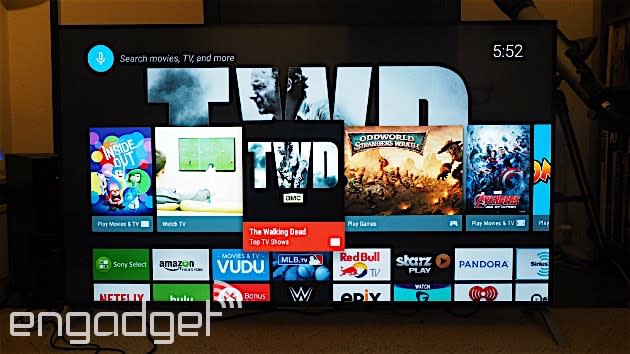Sony's X900C 4K television isn't perfect, but it makes a good case for Android TV

We're already living in the future. Virtually every appliance in the modern home has become smarter thanks to ubiquitous internet connectivity, and the same goes for televisions as well. What used to simply be a monitor has quickly morphed into an all-in-one entertainment system. Heck, even having direct access to your entire online content collection and streaming services without so much as a set-top box is becoming standard fare. But does a TV that's as smart as my cellphone really make for a better viewing experience? To find out, I spent a month consuming my content on the Sony X900C, a ridiculously thin $2,400 (MSRP) flat panel 4K LCD TV, and one of the first powered by the Android TV operating system.
When I say "ridiculously thin," I mean it. The X900C is barely 1.5 inches at its thickest point and just 0.2 inches at its thinnest. Even with the tabletop stand, the 55-inch version that I reviewed weighs less than 40 pounds, making it light enough to set up by myself. (The 65- and 75-inch versions come in at 51 and 74 pounds, respectively.) Installing the stand is straightforward as well: Just slap the pre-assembled feet onto the rear of the set and tighten on a pair of screws for each side. In all, I spent more time trying to fit all the foam packing bits back into the box than I did assembling the set.
Since having a Smart TV these days is about as revolutionary as the X900C's passive 3D system, I'll focus primarily on the set's OS, which is based on last year's version of Android, also known as Lollipop. The initial setup was quite simple. I just signed on to my home Wi-Fi network, input my Google credentials and boom: I had access to all of my existing Google Play Movie and Music libraries. Logging into Hulu, Netflix, HBO Go and other streaming services was a bit of a pain using the remote, though if you have a Bluetooth keyboard, you can easily pair it with the TV and use that instead of pecking your way through an onscreen board.

If you are already heavy into the Google ecosystem like I am -- with an existing Play account and fully populated Movie and Music libraries -- this set makes all sorts of sense. Simply logging onto your existing Google account grants you access to all of these services through the TV. Plus, since it's a Sony, users can also pair the set with their Playstation Network and access their PS3/4 content directly through the TV. If, however, you're big on iTunes and already have a majority of your streamable content over there, this set won't do a whole heck of a lot for you -- best to stick with Apple TV.
Android is quite new to the TV scene. It debuted at the tail end of 2014 as part of the Google Nexus Player but Google has since inked deals with Sony, Philips and Sharp to include them on a variety of television models, and it's also teamed with Razer and NVIDIA for gaming-centric set top boxes. Philips in particular offers Android TV in 80 percent of its 2015 television models -- everything from the 5500 series (which retails for about $1,100) up to the flagship 9600 series (which launches later this month). Unfortunately for our American readers, though, they're only available in Europe.

Android TV user interface is pretty straightforward, with recommendations populating the top third of the screen, apps living in the middle section and games rounding out the bottom. Recommended content comes from all over the Google Play ecosystem -- music from my library, new releases on Play Movies, topical YouTube cat videos all automatically appear whenever I turn on the set.
The apps section in the center is exactly what it sounds like. You have the option to use any of the preinstalled streaming apps or add additional ones from the Play Store. I didn't have much need to add extra applications since anything I couldn't install directly -- say, Crunchyroll -- I could just as easily Cast directly from my mobile device to the TV. I didn't even need a Chromecast (except for the times that it didn't work -- more on that below).

The game section offers a bunch of the same popular games I already play on my phone. While I could very easily mirror my tablet's screen to the TV to play Clash of Clans at 55 inches, I could just as easily install it directly on the set and use an Android controller. Some games, like the shameless Frogger ripoff, Crossy Road, don't even need that. They can leverage the traditional remote's directional buttons to command your chicken through its perilous journey. Best of all, since you're already signed into your Google Play account on the TV, any advancements/achievements you earn on the TV will sync with the mobile copies.
Since this TV runs like an Android device, voice recognition is deeply integrated and works well. The smart remote is rather finicky when it comes to navigating menus, so being able to push a single button, say "Open Netflix" and be instantly delivered to its home screen is particularly helpful. But voice search is far more than just an easy way to launch apps. You can ask it to recommend content starring specific actors, produced by certain directors or even movies that were nominated for an Oscar in 1996.

The Android TV OS performed admirably but wasn't without its hiccups. For one, casting content from my second-gen Nexus 7 directly to the set was a hit-or-miss experience. Netflix and Hulu content played without a hitch but for apps that didn't come pre-installed on the set, like Crunchyroll, playback would often fail to start or randomly skip ahead. I'd have to switch over to a separate input channel to use a physical Chromecast, which totally defeats the point.
There was also one time when the TV, using the onboard Netflix and Hulu apps, would automatically turn off the video (but not audio) of any content I tried to stream. Like, I'd be able to navigate the apps' UIs down to the point where I actually hit play, then the screen would go black. The problem sorted itself easily enough when I unplugged the set, counted to 10 and plugged it back in, but not before a good 20 minutes of self-flagellation for seemingly breaking an expensive television that didn't belong to me. And don't get me wrong, I'm become accustomed to my Nexus 6 and Nexus 7 borking themselves, requiring hard reboots. But having my TV do it introduced all sorts of new stress.

Me after realizing I could fix the "yes audio, no video" issue simply by unplugging the set.
In general, the X900C is a capable 4K television. The set features four HDMI ports (one with MHL support), an Ethernet jack, three USB sockets and an analog tuner as well as various component hookups and specialty outputs. Additionally, it supports Screen Mirroring and Wi-Fi Direct. The X900C also comes with two remotes: a traditional mutli-button wand and a smart remote with gesture and voice recognition. You can also download the Sony Sideview app for your iOS and Android devices, though given that it's little more than a TV Guide on your phone, I wouldn't recommend it.
The X900C's audio output is pretty decent with its quartet of 7.5W drivers. They're enough to be heard over my neighbor's absurd need to run his table saw 15 feet from my window but won't be rattling loose your fillings with overwhelming bass any time soon. The image quality is pretty good. It's an edge-lit IPS display so the black levels and contrast ratio (the difference between the brightest white section and darkest black section) aren't great, especially when you're watching a movie in a fully darkened room. The set offers a 178-degree viewing angle, though with the subpar black levels, you're going to want to sit as close to front dead center as humanly possible for the best effect.
For regular TV, sports coverage and video games, however, the X900C is more than capable -- especially when you turn on the MotionFlow, which all but eliminates judders without creating that weird "Soap Opera" effect. The X900C also does passive 3D, though I only mention it in the off-chance that at least one of you still gives half a shit about that gimmick feature. The set also handles 4K content with aplomb, assuming you've either got access to a stash of 4K Blu-Ray content or a fantabulous Wi-Fi connection because I honestly couldn't tell the difference while streaming over my shoddy wireless hookup.

The X900C has an MSRP of $2,400, which is pricey for a 55-inch set, though you can easily find one for $1200 - $1800 online. That's significantly more than what you'd pay for an entry-level 4K set down at your local big box store. Sure, $1,800 roughly equivalent to the street price of LG's curved 4K set but then you're sacrificing the Android and PSN capabilities for a better picture. Still, unless you're looking for a hardcore reference model (like the Vizio R-Series) or something that you can install in your dedicated home theater, the X900C is a solid, future-proofed set -- especially if you already use Android in your mobile devices. And if you own a PlayStation, this set should be a lock.

